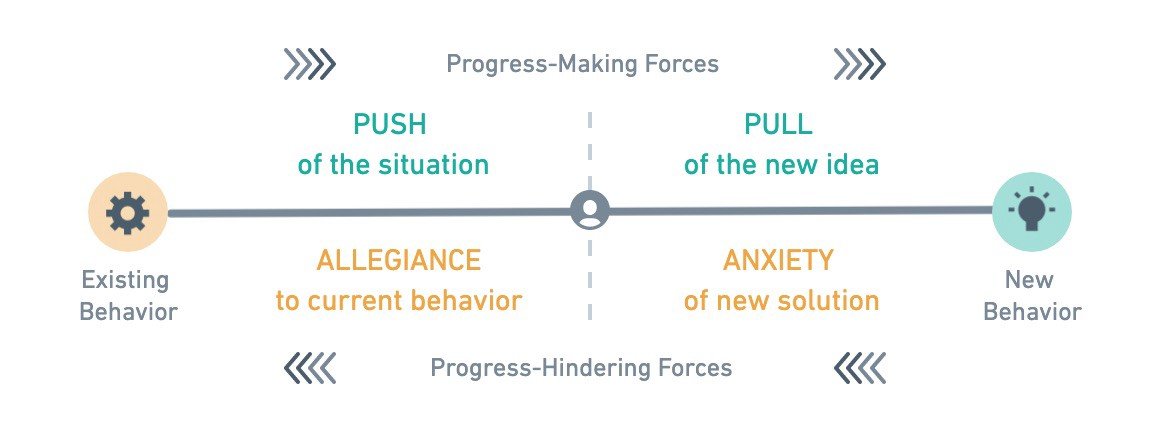I spend most of my days talking to innovation leaders within established companies who are excited about pursuing new projects that live under the umbrella of customer experience. These leaders are excited about the potential that projects like design thinking, journey mapping, and JTBD research can bring to their organizations. But they’re all struggling with the same challenge:
Getting buy-in from leadership.
If you’re facing a similar problem, you’re not alone. Many established organizations — regardless of industry — struggle to embrace design thinking practices.
Why is Getting Buy-In So Hard?
CX research can actually help us understand why getting leadership buy-in can be so hard to do.
The infographic below demonstrates the different behaviors of customers who are buying new products or services. Much like leaders who are deciding whether or not they should invest in a CX initiative, there are a multitude of forces at work in the decision.

Designed by Charissa Morgan, CX Consultant at Highland Solutions
In a business context, the allegiance to “the way it’s always been” and the anxiety about projects going awry is often much stronger than the push to change or the pull of new possibilities.
But there’s hope. I’ve worked with dozens of innovation leaders who’ve successfully navigated office politics in order to pursue the projects that they know will help push their organizations forward. Here’s what I’ve learned from them about how to convince leadership to invest in your new customer experience strategy.
1. Present the macro trends
In today’s experience economy, customer experience is competitive advantage. Leading companies are driving innovation by listening the customer's perception and designing products, services, and experiences to meet customer expectations.
But how can you convince your boss that CX really works? Recent surveys show that it pays to invest in a CX strategy:
- Customer Experience leaders grow revenue 14% faster
- 67% of buyers have left a provider because of a poor or bad experience - this increases customer churn and impacts negatively on retention.
- Nearly 86% of all buyers will pay more for a better customer experience
Sharing the macro trends of the importance of CX can help set the stage for why your business needs CX in order to improve customer success and thrive.
2. Ask the tough question
When is the last time your customer service teams talked to your customer base? (And, no — I don’t just mean through a survey.) When’s the last time you actually picked up the phone or sat down in a room and talked to someone who’s purchased your products or services to learn about the customer's perception?
Operating on the assumption of what you think customers' needs are rather than talking with them directly to follow up can lead to big (and expensive) missteps. Highland recently partnered with Children’s Hospital of Wisconsin on a customer journey mapping project to help them better understand the experiences of parents and children in their ER. According to Christopher Neuharth, CHW’s Director of Digital Health & Experience, the information they learned through the journey mapping process was critical in helping them make the right business decisions:
“Had we not done this process we likely would have invested money in the wrong sort of technology. The journey mapping process helped dramatically decrease our risk in technology selection and got us pointed in the right direction as a new team.”
If your leadership team is hesitant about exploring new CX initiatives, try asking them when you last talked with your customers. If it’s a tough question to answer, it might be time to reconnect with the people who make your business possible.
3. Get them involved
Getting leadership directly involved in a short, high-impact CX project is a great way to expose them to customer-centric thinking and get them excited about potential outcomes. There are a few simple and fun ways to do this:
- Try running a one-day design dash (a shorter version of a design sprint) to solve an internal challenge. Choose a challenge that is easy to tackle but will make an impact. Here’s all the design sprint documentation you could ever need.
- Bring in an outside facilitator to lead a strategy session. These sessions can help businesses identify the high-priority issues that they’re facing as an organization and understand which CX initiatives are best suited to solve them. Highland facilitates meetings like this all the time (and they’re affordable!) — you can get in touch if you want to learn more about them.
- Do a few customer interviews to demonstrate the value of direct customer feedback. We use an interview format called Guided Storytelling that helps customers unpack the experience of interacting with your product, messaging or service and to highlight pain points. We created a one-page guide with tips on how to conduct a great Guided Storytelling interview.
- Create your own customer journey map. If you’ve got a bit more time, we created a guide on how to create your own journey map in just four weeks!
4. Find quick wins
If your CX project is already off the ground but you need more leadership buy-in to keep it going, it’s important to find quick wins! Show leadership how talking to customers is already making a positive impact on the organization and leading to strategic insights that you wouldn’t have gained otherwise.
In our recent work with the American Marketing Association, we ran a design sprint to help them develop a new offering for their members. Scott Stern, their Director of Innovation & Insights, shared that after moving past some initial doubts about the power of design sprints, his team found the process so impactful that they decided to have their entire board participate in a sprint at their annual meeting. This is a great example of building on moments of enthusiasm and identifying allies who can help you convince other people in your organization of the power of customer experience management.
5. Establish goals and track ROI
Demonstrating the ROI of CX can be notoriously tricky. There are so many inputs to a great customer experience, and it can be hard to connect impact to a particular change or initiative. What value do you place on customer loyalty and the positive word of mouth generated from customer engagement?
In a recent blog post for Clutch, Highland’s President Jon Berbaum recommended tracking the ROI of CX by first clearly understanding the kind of CX initiative you’re proposing and then identifying some simple baseline metrics and customer interaction touchpoints that will show leadership that an investment in CX is worth it.
You can learn more about how we track the ROI of CX here: How to Measure the ROI of Customer Experience
Getting buy-in from leadership can be one of the toughest parts of embarking on a new CX initiative to improve the customer relationship, but there are plenty of pioneers who have been in your shoes before. Ultimately, when it comes to creating loyal customers, your pricing isn't always the key differentiator but instead customer experience and other aspects such as customer support can have a real impact on your business performance. I hope some of the strategies above empower you to feel more confident when talking to leadership about the value of CX and why it’s so important. Contact us and find out more about how to convince leadership today.



